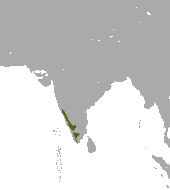Brown palm civet facts for kids
Quick facts for kids Brown palm civet |
|
|---|---|
 |
|
| Illustration by Joseph Smit (1885) | |
| Conservation status | |
| Scientific classification | |
| Genus: |
Paradoxurus
|
| Species: |
jerdoni
|
 |
|
| Brown palm civet range | |
The brown palm civet (Paradoxurus jerdoni), also known as the Jerdon's palm civet, is a unique type of palm civet. This amazing animal lives only in the Western Ghats of India. It is a shy creature that mostly comes out at night.
Contents
What is a Palm Civet?
A palm civet is a small mammal that looks a bit like a cat or a ferret. They are part of a family of animals called Viverridae. Most palm civets live in trees and are active after the sun goes down. They are known for their long tails and often have interesting patterns on their fur.
Where the Brown Palm Civet Lives
The brown palm civet is special because it lives only in one place. This place is the Western Ghats, a long mountain range in southwestern India. This area is a biodiversity hotspot, meaning it has many different kinds of plants and animals. The civet lives in the forests there, from the lowlands up to the mountains.
Forest Homes
These civets prefer evergreen forests, which are forests where trees stay green all year. They also live in moist deciduous forests, where trees lose their leaves in the dry season. They can be found in both untouched forests and areas where people have planted coffee or other crops.
Appearance and Features
The brown palm civet gets its name from its fur color. It has a dark brown coat, sometimes with a slightly reddish tint. Its fur is often shaggy, especially on its body.
Size and Shape
This civet is about the size of a small house cat. Its body can be around 43 to 59 centimeters (17 to 23 inches) long. Its tail is almost as long as its body, helping it balance when climbing trees. An adult brown palm civet usually weighs between 3.6 and 4.3 kilograms (8 to 9.5 pounds).
Unique Markings
Unlike some other civets, the brown palm civet does not have spots or stripes. Its fur is mostly plain brown. However, some individuals might have a lighter patch on their throat or chest. Their eyes are usually dark, and their ears are small and rounded.
What They Eat
Brown palm civets are mostly frugivores, which means they love to eat fruit. They play an important role in the forest by spreading seeds from the fruits they eat. This helps new plants grow.
A Varied Diet
While fruit is their main food, they also eat other things. They might snack on insects, small rodents, or even birds' eggs. Sometimes, they will eat leaves or bark. This varied diet helps them get all the nutrients they need.
Finding Food at Night
Since they are nocturnal, brown palm civets hunt for food in the dark. They use their excellent sense of smell and hearing to find ripe fruits and other tasty treats. They are skilled climbers, easily moving through the trees to find food.
Behavior and Lifestyle
Brown palm civets are generally solitary animals. This means they prefer to live alone rather than in groups. They are very secretive and shy, making them hard to spot in the wild.
Nocturnal Habits
These civets are most active at night. They spend their days resting in tree hollows, dense bushes, or sometimes even in abandoned buildings. When night falls, they wake up and begin their search for food.
Tree Dwellers
Brown palm civets are excellent climbers. They spend a lot of their time in trees, using their strong claws and long tails to move easily from branch to branch. This helps them find food and stay safe from predators on the ground.
Conservation Status
The brown palm civet is currently listed as "Least Concern" by the International Union for Conservation of Nature (IUCN). This means that their population is stable and not immediately threatened.
Why They Are Safe (For Now)
One reason they are doing well is that they can live in different types of forests, including those near human areas. They are also protected in some parts of the Western Ghats, which are national parks or wildlife sanctuaries.
Future Challenges
Even though they are "Least Concern" now, their habitat is still at risk. Forests are sometimes cleared for farming or development. It is important to continue protecting their homes to make sure these unique civets thrive for many years to come.
Images for kids
See also
 In Spanish: Civeta palmada de Jerdon para niños
In Spanish: Civeta palmada de Jerdon para niños





